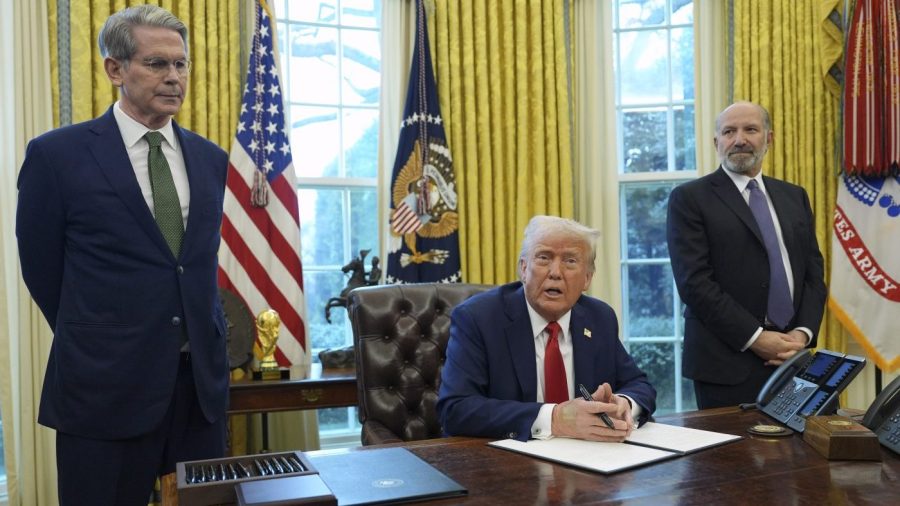
President Trump signed an executive order last week to create a sovereign wealth fund — something previously decried by both market-oriented conservatives and corporate-skeptic progressives. The secretaries of the Treasury and Commerce have 90 days to develop a plan.
But what are the president and his team actually trying to accomplish? We have to look beyond conventional economic and political objectives. The likely goal is much more daring: rebalancing global trade flows and capital holdings in the American government’s favor.
Sovereign wealth funds are government-owned investment vehicles. They have the same purpose as private portfolios — namely, generating financial returns. Proponents of sovereign wealth funds argue the yields can be used as substitutes for taxes, to pay down the national debt or advance broader social goals, such as reducing inequality. More than 100 countries have sovereign wealth funds, totaling approximately $13 trillion in assets. Now the U.S. is poised to join them.
Trump’s executive order lists many familiar-sounding benefits to creating a sovereign wealth fund. Phrases like “economic growth” and “national competitiveness” permeate the White House fact sheet. But these aims, while worthy, hardly distinguish sovereign wealth funds from any other policy proposal. In reality, the Trump administration is after bigger and more dangerous game.
The correct paradigm for understanding an American sovereign wealth fund is Stephen Miran’s white paper about “restructuring the global trade system.” Miran, whom Trump has nominated for chairman of the Council of Economic Advisors, wants to lessen the costs and increase the benefits associated with global dollar hegemony. That means using tariffs and currency policy (i.e., exchange rate interventions) to devalue the dollar, force allies to bear a larger share of their collective defense costs and protect national security-related supply chains. A sovereign wealth fund would be an important part of the overall policy machine.
Because the dollar is the world’s reserve currency, and U.S. Treasuries the world’s reserve asset, America continually sends dollars and dollar-denominated debt abroad. Global economic growth increases the demand for these assets. Absent a corresponding increase in supply, borrowing costs for the U.S. government decline. This encourages federal policymakers to borrow more.
The net effect is that the increased demand for U.S. Treasury securities tends to be met with increased supply, with the government going deeper into debt. While this system allows our government to borrow more than it otherwise could — and, equally important, to impose crippling sanctions on dollar-using adversaries — it creates serious domestic problems. The most pressing are the erosion of the defense-industrial base and an unsustainable debt-to-GDP ratio.
Enter the sovereign wealth fund. Treasury Secretary Scott Bessent wants to keep budget deficits below 3 percent of GDP. Greater fiscal discipline is welcome. However, a reduction in the flow of new debt would drive the federal government’s borrowing costs lower. That gives policymakers an incentive to borrow and spend more — probably on wasteful pet projects that decrease national wealth.
Instead, the sovereign wealth fund could issue debt to purchase both domestic and foreign assets. As a result, the fund would improve the government’s fiscal discipline while generating returns. The flow of dollars abroad would continue if the fund prioritizes international investments. Meeting global dollar demand via this alternate route lowers the adjustment costs of the U.S. shoring up its abysmal fiscal position.
Hence we can make sense of the sovereign wealth fund if we adopt a fundamentally different perspective on the role of American finance in the world economy. Instead of serving as a de facto global underwriter, our government can wield the fund as part of a strategy to use its low borrowing rates, induced by dollar reserve status, to acquire a larger share of the world’s wealth.
This would allow the U.S. to recreate an important characteristic of the Bretton Woods system, which prevailed from 1944 until 1971. Under that system, private dollar investments in Europe were exchanged at central banks for domestic currency. These central banks then used dollars (at U.S. government urging) to purchase Treasury securities, thereby lowering yields. Lower yields led to lower borrowing costs more generally, which benefited the American government and also facilitated private investment in Europe.
Bretton Woods had an additional constraint — foreign central banks could redeem the dollar for gold — that doesn’t exist today. That’s why the sovereign wealth fund can help to mitigate the incentives for fiscal profligacy with a dollar that is the global reserve yet purely fiat.
Admittedly, there are many practical concerns with establishing a sovereign wealth fund. It is unclear how it would be financed at the beginning. Tariff and domestic tax revenues seem a poor choice, given our budgetary woes. It’s also worth remembering that politicians and bureaucrats are frequently poor stewards of capital. If the fund becomes a political football, the party in power may undermine its strategic worth by diverting its resources towards partisan ends. And even civically minded sovereign wealth fund managers would lack the high-powered information and incentives their private-sector counterparts enjoy.
The biggest risk is that the overall plan the sovereign wealth fund is supposed to serve could backfire. Perhaps it invites international reprisals, or the structural adjustments at home cause so much chaos that the president calls it quits.
We can debate whether a sovereign wealth fund would achieve the ends the Trump administration seeks, as well as whether these ends are moral. But it’s important to understand policymakers on their own terms. We won’t get anywhere if we assume public actors are totally irrational or systematically misinformed.
An American sovereign wealth fund is undoubtedly ambitious, unconventional and risky. It may yet deliver what the president and his team want.
Joshua R. Hendrickson is the chairman of the economics department at the University of Mississippi. Alexander William Salter is an economics professor in the Rawls College of Business at Texas Tech University and a research fellow at TTU’s Free Market Institute.












